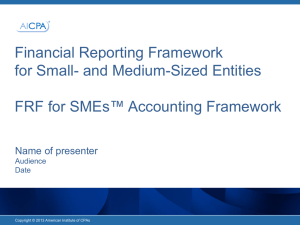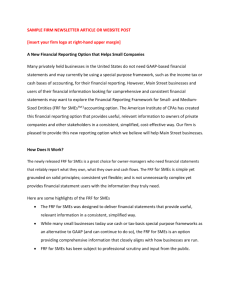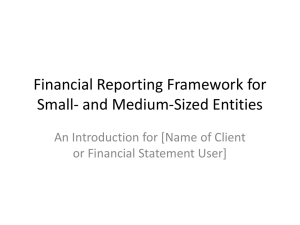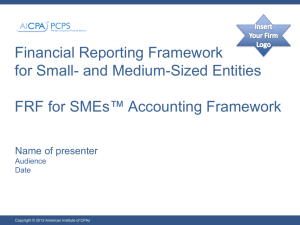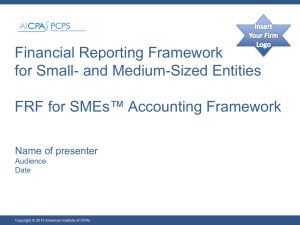Materials
advertisement
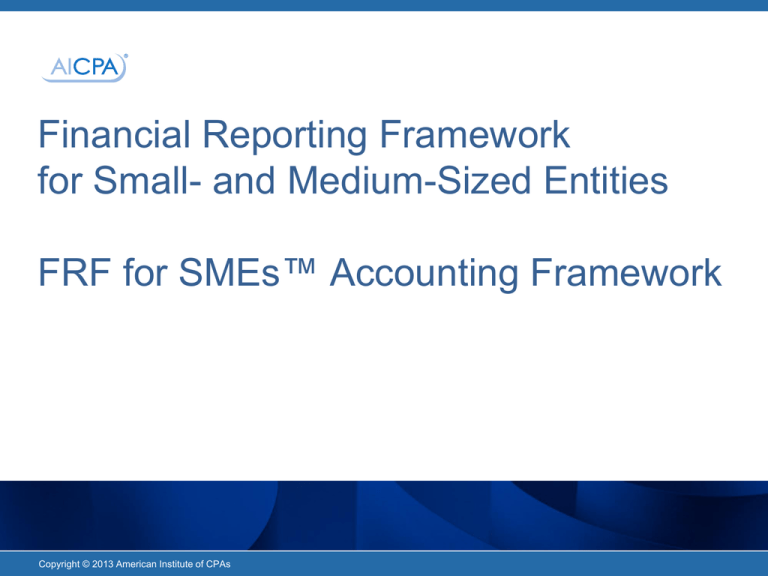
Financial Reporting Framework for Small- and Medium-Sized Entities FRF for SMEs™ Accounting Framework Copyright © 2013 American Institute of CPAs America’s Main Street businesses Small- and medium-sized entities pervade the business world and form the backbone of the US economy They provide goods and services in a wide-range set of activities and are active in many industry groups No standard definition of SME in US Current SPF reporting environment Special Purpose Frameworks (OCBOA): US GAAP Not Required GAAP not required for many small- and mediumsized entities IFRS for SMEs Lack of familiarity, higher learning curve, not UScentric, form of GAAP Other Special Purpose Frameworks Tax or modified cash basis may be inappropriate or insufficient for some SMEs/users Another option… ... a framework to deliver tailored financial reporting for America’s small business community … a framework with streamlined, common-sense requirements based on traditional and proven accounting methods … a framework to provide robust, meaningful financial reports to business owners, lenders, insurers and others without needless complexity It’s here An additional non-GAAP framework Separate from FAF and PCC FRF for SMEs - Not GAAP - Special Purpose Framework - Complementary to efforts by FAF’s PCC - AICPA fully supports the work of the PCC, FAF and FASB to address the private company environment Private Company Council - GAAP - Modify GAAP for private companies HISTORIC TIME FRF for SMEs overview Responsive Addresses well-documented financial reporting issues and concerns among SMEs Cost effective Comprehensive yet relevant information Tailored Designed to suit financial reporting needs of SMEs and users of their financial statements Who could use it? For use when GAAP-based financial statements are not needed – Small and medium-sized entities – Owner-managed/for-profit – Can be used by any industry group – Incorporated and unincorporated Who is it for? Owner-Managers Depend on reliable financial statements to – Confirm assessments of performance – Determine what they owe/own – Understand cash flows Users External financial statement users who have direct access to management Non-issuers No intent of going public Characteristics of typical entities – Entity does not operate in an industry that has highly specialized accounting guidance – such as financial institutions and governmental entities – The entity does not engage in overly complicated transactions – The entity does not have significant foreign operations – Financial statement users may have greater interest in cash flows, liquidity, statement of financial position strength and interest coverage Features – Standalone framework – Concise – Suitable criteria for general-use financial statements – Accrual based – Blend of traditional accounting and accrual income tax methods – Fewer adjustments from book to tax Features – Excess narrative avoided – Eschews prescriptive rules – Use of professional judgment – Intuitive and understandable – Stable yet nimble Features Relevant Only relevant financial reporting topics included (e.g., no comprehensive income/OCI) Simplified Simplified principles (e.g., no VIEs, no complicated derivative/hedge accounting or stock compensation rules) Authority and effective date The AICPA has no authority to require the use of the FRF for SMEs accounting framework for any entity Use of the framework is purely optional Management represents that such financial statements have been prepared in accordance with the AICPA’s FRF for SMEs accounting framework, a special purpose frame-work Because use of the framework is optional, there is no effective date for its implementation Benefits CPAs CPAs serve as … ... a credible, knowledgeable professional who applies the most up-to-date accounting tools and practices ... a trusted business advisor with the broad perspective to provide strategic insights The FRF for SMEsTM framework delivers SME owner-managers Owner-managers need ... ... reliable and understandable financial information to inform business decisions ... ways to control costs The FRF for SMEs framework delivers Lending community/users Bankers, sureties and other interested parties ... ... need to get financial information that is relevant and clear so they can make informed decisions ... want to help customers realize cost-savings and efficiencies where possible The FRF for SMEs framework delivers Reaching Out to Lenders/Users FRF for SMEs answers banker needs – With substantial relevance and cost-benefit factors, the AICPA believes that the lending community will accept financial statements prepared under the FRF for SMEs – Reliable, principles-based framework Lending community/users can rely on FRF for SMEs – CPAs across the country worked to develop the Framework – Considered the needs of users of private company financial statements – Framework subjected to rigorous professional scrutiny and public input Outreach goals – lending community – Inform and educate – Explain benefits – Drive home… …reliability of FRF for SMEs …ability of FRF for SMEs to deliver relevant information Banking regulators/acceptance – Discussed FRF for SMEs with regulators/exam chiefs – Bankers accept OCBOA today – Flexible with smaller businesses Key Principles Historical cost Framework primarily uses historical cost basis, steering away from complicated fair value measurements Most relevant and reliable measurement basis for small business financial reporting needs Well-suited as a metric for evaluating an entity’s cash flow Objective, verifiable, straight-forward Historical cost Directly relates to the past experience and past decisions of an entity Sound basis for financial forecasts Best measurement basis to help evaluate the performance of a small business. Stands the test of time Optionality in certain accounting policies More relevant and tailored approach to financial reporting Answers the varying informational needs of different financial statement users Financial reporting that is truly representative of the underlying economics of a small business Optionality in certain accounting policies Provide users with the most decisionuseful information Optionality nothing new to accountants – make choices today Well-suited to small business community where financial statement users commonly have direct access to management. Primary accounting policy options Income tax accounting − taxes payable method or deferred income taxes method Subsidiary accounting − consolidate or equity method Joint venture accounting − equity method or proportionate consolidation (only applicable to unincorporated entities when it is an established industry practice) Primary accounting policy options Long-term contracts and service contracts −percentage of completion method or the completed contract method • Completed contract method is used when the entity cannot reasonably estimate the extent of progress toward completion. • Completed contract method may also be used if both of the following conditions are met: a. Used for income tax reporting purposes. b. Financial position and results of operations would not vary materially from those resulting from the use of the percentage of completion Primary accounting policy options Intangible assets acquired in a business combination − separately recognize or subsume into goodwill Internally-generated intangible assets − expenditures during development phase, either expense or capitalize Certain Interest costs − expense or capitalize interest costs related to certain items of inventories, internally-generated intangible assets, and PP&E Defined benefit plans − current contribution payable method or one of the accrued benefit obligation (ABO) methods Targeted disclosures Only targeted disclosures in the financial statements Stakeholders receive the pertinent, understandable information they need Avoid excess narrative or irrelevant “noise” in the financial reports Targeted disclosures External users of a small business’s financial statements usually possess a familiarity and knowledge about the entity They have direct access to the management The value of financial statements to such users lies in its capacity to confirm and supplement a user’s knowledge and expectations about the business Targeted disclosures Results − Financial disclosures that are relevant, transparent, clear and decision-useful No sifting through voluminous information in search of the pertinent information If a user requires additional information about the business, management can tailor the nature and extent of disclosures to suit those needs Specific Accounting Areas Table of contents (comprehensive yet relevant) Financial Statement Concepts General Principles of Financial Statement Presentation and Accounting Policies Transition Accounting Changes, Changes in Accounting Estimates, and Correction of Errors Risks and Uncertainties Equity, Debt and Other Investments Statement of Financial Position Inventories Current assets/liabilities Intangible Assets Special Accounting Considerations for Certain Financial Statement of Operations Statement of cash flows Property, Plant and Equipment Disposal of Long-lived Assets and Discontinued Operations Table of contents (comprehensive yet relevant) Commitments Interests in Joint Ventures Contingencies Leases Equity Revenue Related Party Transactions Subsequent Events Retirement and Other Postemployment Benefits Business Combinations Income Taxes New Basis (Push-Down) Accounting Subsidiaries Nonmonetary Transactions Consolidated Financial Statements and Noncontrolling Interests Foreign Currency Translation Lease accounting Familiar accounting/Aligned with U.S. tax code Criteria for capitalizing a lease for tax purposes generally matches criteria in FRF for SMEs Overriding concept of transferring substantially all the benefits and risks of ownership to the lessee Reduction of book to tax adjustments Subsidiaries & consolidation Entity should make an accounting policy choice to either - consolidate its subsidiaries OR - account for its subsidiaries using the equity method Parent-only (unconsolidated) financial statements permitted No Concept of Variable Interest Entities (VIEs) Simplified Model Investments Investor that is able to exercise significant influence over an investee that is not a subsidiary follows the equity method Not able to exercise significant influence - follow the cost method If the investor holds 20 percent or more of the voting interest in the investee, there is a rebuttable presumption that the investor has the ability to exercise significant influence Investments held for sale Equity and debt investments held for sale should be recognized and measured at market value. Changes in market value should be recognized in net income in the period incurred. Derivatives Recognized at settlement – net cash paid or received Disclose pertinent information - Face or contract amount (or notional principal amount) - Nature and terms - Discussion of the credit and market risk and cash requirements - Description of objectives - Net settlement amount Revenue Recognition Performance Revenue from sales and service transactions should be recognized when the requirements regarding performance are satisfied, provided that at the time of performance, ultimate collection is reasonably assured The seller of the goods has transferred to the buyer the significant risks and rewards of ownership Reasonable assurance exists regarding the measurement of the consideration Goodwill No impairment testing Goodwill should be amortized generally over the same period as that used for federal income tax purposes or if not amortized for federal income tax purposes then a period of 15 years Push-down accounting Assets and liabilities may be comprehensively revalued by means of push-down accounting when an acquirer gains control of an entity Control of an entity is gained when more than 50 percent of the outstanding residual equity interests in the entity have been acquired When an acquirer gains control of an entity a new cost basis for a continuing entity is established Reporting by CPAs Reporting by CPAs CPAs performing audit, review or compilation engagements on financial statements prepared under the FRF for SMEs will follow the same standards as they do today when reporting on other SPF financial statements • Compilation: AR section 80, Compilation of Financial Statements • Review: AR section 90, Review of Financial Statements • Audit: AU-C section 800, Special Considerations— Audits of Financial Statements Prepared in Accordance With Special Purpose Frameworks Sample standard review report Independent Accountant’s Review Report Board of Directors XYZ Company ↓ [last paragraph] Based on our review, we are not aware of any material modifications that should be made to the accompanying financial statements in order for them to be in conformity with Financial Reporting Framework for Small- and MediumSized Entities™, as described in Note 1. [Signature of accounting firm or accountant, as appropriate] [Date] Sample basis of presentation note The accompanying financial statements have been prepared in accordance with the Financial Reporting Framework for Small- and Medium-Sized Entities issued by the American Institute of Certified Public Accountants. This special purpose framework, unlike generally accepted accounting principles (GAAP) in the United States of America, does not require the recognition of deferred taxes. We have chosen the option to recognize only current income tax assets and liabilities. Other primary differences would be described as necessary. Peer review implications Responsibilities no different from what they are today Needs familiarity with the performance and reporting standards of the SASs or the SSARS, as well as the FRF for SMEs framework. Must apply professional judgment to determine if the recognition, measurement, presentation and disclosure principles followed are appropriate in determining whether the CPA’s report is correct FRF for SMEs Toolkits Slide No. 52 Toolkit tour Visit aicpa.org/FRF-SMEs 3 toolkits available Slide No. 53 Toolkit tour CPA toolkit – client-facing materials and internal resources Option for B&I members Slide No. 54 CPA landing page Segmented by firm size Slide No. 55 Resources: Client-facing materials And more…. Slide No. 56 Summarizes chapters in FRF for SMEs Includes sample CPA reports: - Compilation - Review - Audit Slide No. 57 Illustrative financial statements Slide No. 58 Comparisons with other frameworks FRF for SMEs U.S. GAAP Tax basis OCBOA IFRS for SMEs Slide No. 59 PowerPoint for use with clients/users Brand with firm name/information Slide No. 60 Logo for firm use Guidelines, FAQ on website Slide No. 61 Backgrounder Slide No. 62 Flyer for clients, users Hand out / mail QR code to mobile page with information and educational resources Slide No. 63 Client letter - template Send to potential adopters Slide No. 64 Disclosure checklist Slide No. 65 Application guidance Slide No. 66 Additional resources Social media support (LinkedIn, Facebook, Tweets, Foursquare) #MainStFinancials – ongoing conversation Article for website and/or newsletter/mailer Short video – social media, meetings, presentations Slide No. 67 Questions? Financial Reporting Framework for Small- and Medium-Sized Entities FRF for SMEs™ Accounting Framework Copyright © 2013 American Institute of CPAs
